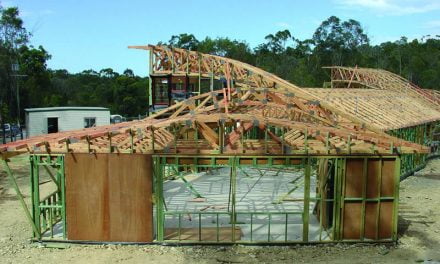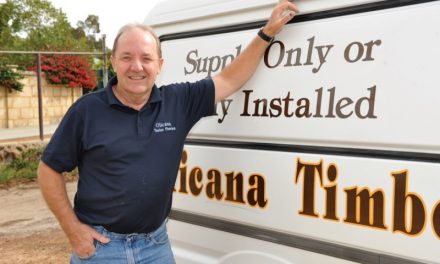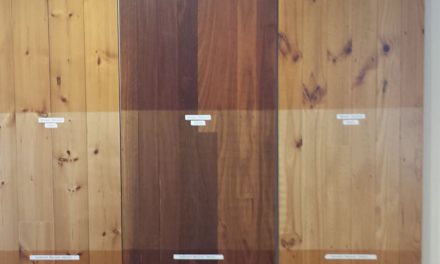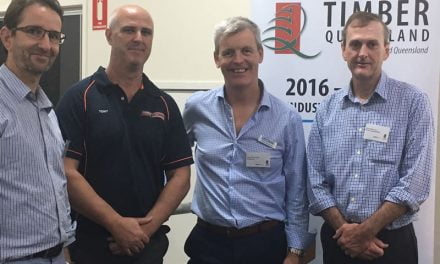STARTING OUT
I left school in 1989, and I wasn’t sure what I was going to do as far as a career. I thought I wanted to be a builder, so I went and got a job in the local timber yard called Leisure Logs.
I intended to work there to meet builders and get an apprenticeship. I continued working in the timber industry, and just never left.
Today, I run the business alongside my old friend Colin Tippett, Darren de Joux, and my mother Trish Epthorp – and it works well!
IN BUSINESS
We buy and sell hardwood timbers predominantly. We market timbers from various sawmills in New South Wales and Queensland, and we trade and wholesale timber, predominantly to other merchants, and the palette and packaging game. Most of the mills that we deal with don’t have a salesperson, as all of their employees pretty much stay in the mill and focus on the daily production.
We don’t have a warehouse, but we do have a large stock of items that we turn over a lot, which we either keep at the mills or at some storage yards here in Sydney. The majority of our stock will go direct from the mill to the store, to another depot, or wherever it has to go, Australia-wide.
INFLUENCE
During my time at Warringah Timbers I got to meet a lot of the long-term wholesalers in the Sydney industry. Like all the big wholesalers who would come in there, a transaction was not a typical business transaction, it was more of a heckle. So I learnt a great deal there, especially about dealing with people and how to get a deal done.
At that time in my life, John Maris and George Zammit were my biggest mentors, between those two, they definitely showed me a different perspective of the timber industry.
SCOPE
I would say that 40 per cent of our business is in Victoria, 50 per cent in New South Wales, and 10 per cent between South Australia and Queensland.
The fact is that there are a lot of traditional markets up where the suppliers have their customer base already, and we were never big in Queensland (QLD) originally. It is only recently that we have witnessed a resurgence in QLD, because more merchants (or buyers up in that area), who were originally getting their product from a mill, have since required an alternative following the closures of many sawmills.
We are now finding they’re calling us to look for an alternative supply to what they were getting before. We are able to step in and pick up some of that slack, and because of that, business is booming.
TIMBER FLOORING SOARS
We have been doing quite a lot lately in flooring and decking products, and we’ve found that this area has become pretty competitive.
We have also found that the majority of our customers who were buying traditional timber flooring have now switched over to engineered flooring products, which they tend to buy direct from the manufacturer.
We’ve found that we’ve lost a pretty big market in the timber flooring sector because of that shift.
IMPORTED PRODUCTS
We don’t sell much imported product. We do sell a little bit of exporting of product – and we’ve got a couple of customers in Japan and New Zealand that we deal with from time to time.
We have had a couple of discussions about importing timber, but we have found that it’s been a bit out of our depth, so it is smarter for us to stick with what we know, which is selling locally produced timber products including Australian hardwoods, both green and dry.
AUSTRALIAN HARDWOODS CONTINUE TO BE POPULAR
I think it has been a mix of effective marketing and there is definitely been some projects that have caught the public’s eye, often through some of the new television renovation shows.
As a result, I believe the public today are really embracing the natural character and properties of Australian timber.
PICK OF THE BUNCH
You can’t beat Iron Bark for many applications, and I still think that it’s quite impressive, based on some of the sizes that we are still able to produce in this day and age.
For example, we can still produce a 350 by 350 hardwood, up to 12 m long, in reasonable numbers for many projects. I’m still blown away that we can do that today with the amount of limited log resources that is available.
MAKING SURE IT’S RENEWABLE
I think the most important thing to understand today is that every sawmiller out there is a conservationist: they know what’s best for the environment. They work with it every day, and they have been for generations.
They see the forests first-hand and they know what is going on, and I think they’re the key to driving the industry forward.
When it comes to our industry being sustainable, all of our industry’s timber is sustainable, as far as I am concerned. It would be pretty hard to obtain timber illegally in this country!
WHAT PEOPLE DON’T REALISE
A lot of people don’t know that many applications for timber occur away from the public eye, especially in commercial applications.
Did you know that there are certain applications for timber to be used in sewer treatment plants when they can’t use metal products? The possibilities for timber are flexible, and it means that this market is constantly expanding.











